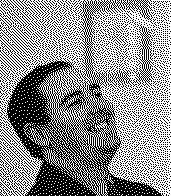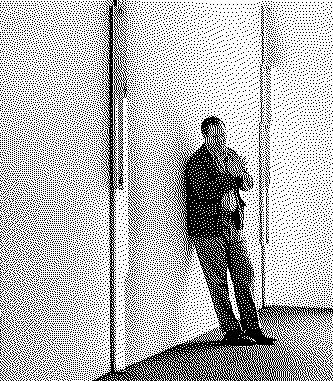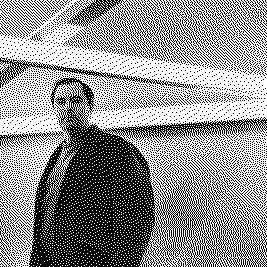Artists/Dan Flavin
Fast Facts
Fluorescent Light as Medium
Flavin's most notable contribution to art was his use of commercial fluorescent light tubes. This unconventional medium was central to his work from the early 1960s until his death.
Minimalist Approach
His work is characterized by a minimalist aesthetic. Flavin's art focuses on simplicity and the interplay of light and space, using the inherent qualities of fluorescent light to transform and define the space in which the work is displayed.
Use of Color and Light
Although he initially used white or off-white lights, Flavin later incorporated colored tubes in his pieces, creating vibrant, immersive environments and exploring the possibilities of color and light as artistic elements.
Architectural Interaction
Many of Flavin's works are site-specific, designed to interact with the surrounding architecture. His installations can transform the perception of space through light and color.
Biography



Dan Flavin, born April 1, 1933, in Jamaica, Queens, New York, was a pioneering figure in Minimalist art, renowned for his innovative use of fluorescent lighting to create striking installations.
His work fundamentally altered the way light and space are perceived in art, merging the physical and the ephemeral in immersive experiences that resonated deeply with viewers. Flavin passed away on November 29, 1996, in Riverhead, New York, but left behind a legacy that continues to influence contemporary art.
Raised in a modest Queens neighborhood by Catholic parents, Flavin exhibited artistic inclinations from a young age. Initially drawn to the priesthood, he entered the high school of the Immaculate Conception Preparatory Seminary in 1947 alongside his twin brother, David, although his feelings towards religion remained ambivalent. Flavin's early encounters with art were nurtured by a family friend who encouraged his drawing, a passion that persisted through his teenage years, often focusing on wartime scenarios inspired by bubble gum picture cards.
Flavin's journey took a significant turn when he and his brother enlisted in the U.S. Air Force in 1953. Stationed in Korea as an air weather meteorological technician, Flavin had the opportunity to take art classes through an adult extension program of the University of Maryland. This period was crucial for his development as an artist, providing him with formal education in art and the chance to start an eclectic art collection. After returning to New York, Flavin pursued further education in art, attending the Hans Hofmann School of Fine Arts and studying art history at the New School for Social Research and Columbia University.
Flavin's artistic focus shifted dramatically in the early 1960s. Initially working with assemblages and paintings inspired by Abstract Expressionism, he began experimenting with electric lights in his series of "icons," merging light with monochromatic canvases. This experimentation led to a significant breakthrough in 1963 with "The Diagonal of May 25, 1963 (to Constantin Brancusi)," his first work to use only fluorescent light. This pivotal piece marked Flavin's full commitment to exploring the artistic possibilities of light, effectively launching his career as a minimalist artist.
By 1968, Flavin had begun to develop his sculptures into room-size environments of light, or "situations," which aimed to transform architectural spaces with colored light. His work from this period, such as the ultraviolet light-filled gallery at Documenta 4 in Kassel, Germany, and later, complex corridors that played with viewer perception, showcased his growing interest in the relationship between light, color, and space. Flavin's installations were not just visual experiences but also immersive environments that engaged viewers in a dialogue with their surroundings.
Throughout the 1970s and 1980s, Flavin's works became increasingly ambitious, culminating in significant installations that highlighted his interest in site-specific art. Despite challenges, including his health in the later years, Flavin continued to innovate, leaving a profound impact on the field of light art.
Flavin's contributions to Minimalism and light art were monumental. His works are characterized by their simplicity, transformative use of commercially available materials, and profound engagement with the spaces they inhabit. Through his explorations of light and space, Flavin not only expanded the boundaries of sculpture but also influenced subsequent generations of artists. His installations, characterized by their ephemeral quality and reliance on fluorescent tubes, underscore a unique aspect of Minimalism—the impermanence and intangible nature of light itself.
Flavin's art is housed in various prestigious collections worldwide, including permanent installations at the Dan Flavin Art Institute in Bridgehampton, New York, and significant pieces at the Chinati Foundation in Marfa, Texas. His innovative use of fluorescent light not only reshaped the landscape of contemporary art but also left a lasting legacy that continues to inspire (Wikipedia) (Encyclopedia Britannica) (Artland Magazine) (The Art Story).
Importance
Dan Flavin's significance in the art world can be encapsulated through his innovative use of light as a medium, his contribution to Minimalism, and his influence on subsequent generations of artists. His work redefined the boundaries between sculpture and installation art, transforming spaces with the ethereal play of light and color.
Minimalism and the Use of Light
Flavin is celebrated as a pioneer in Minimalism, with his signature fluorescent light installations. By choosing commercially available fluorescent tubing as his sole medium, Flavin stripped art down to its elemental form, challenging traditional notions of sculpture and the sanctity of the art object. His work embodies the Minimalist ethos of simplicity and objectivity, emphasizing the artwork's physical presence and its environmental impact (Artland Magazine).
Transforming Spaces with Light
Flavin's installations, or "situations" as he preferred to call them, were groundbreaking in their ability to transform architectural spaces. By carefully arranging light fixtures, he could alter the perception of space, enveloping viewers in immersive environments of colored light. This approach not only highlighted the architecture of the space but also engaged viewers in a phenomenological experience, encouraging a deep, personal interaction with the artwork (Artland Magazine).
Innovative Techniques and Conceptual Approaches
Throughout the 1970s, Flavin experimented with more complex arrangements of fluorescent tubes, including his "barred corridors" series. These works disrupted the conventional experience of space by forcing viewers to navigate around or through his installations, thereby engaging with sculpture and space from multiple perspectives. This innovation exemplified his interest in the interplay between light, space, and the viewer, pushing the boundaries of how art can inhabit and define space (Artland Magazine).
Legacy and Influence
Flavin's influence extends beyond his contributions to Minimalism and the specific medium of light. His conceptual approach to art, emphasizing simplicity, the transformation of space, and the direct engagement of the viewer, has inspired generations of artists. His work paved the way for contemporary installation art and continues to be a reference point for artists exploring the material and immaterial qualities of light and space (TheCollector).
Cultural and Artistic Dialogues
Flavin was deeply influenced by Russian Constructivism, particularly the work of Vladimir Tatlin. This influence is evident in his series of works dedicated to Tatlin, which reflect Flavin's appreciation for art as a utilitarian vehicle and his interest in the intersection of art, technology, and modernity. Through these tributes, Flavin engaged in a broader dialogue about the role of art in society and the potential for materials to carry conceptual weight (TheCollector).
Technique
Dan Flavin's technique evolved through distinct phases over his career, showcasing his innovative approach to art and light.
Transition to Light
Flavin's significant shift towards using light as his primary medium occurred in the early 1960s. He began constructing the "Icons," combining electric or fluorescent bulbs with blank canvases, emphasizing the objecthood over the artist's touch. This period marked Flavin's departure from traditional materials towards a more conceptual representation of light and space (The Art Story).
Mature Technique and "Situations"
By 1963, Flavin exclusively used fluorescent bulbs, aligning with contemporary art movements and emphasizing mass-produced, commonplace materials. His work with fluorescent lighting was not just about the bulbs themselves but their arrangement, color, and the way they interacted with and transformed their surrounding space.
Site-Specific Installations and Later Works
In the later stages of his career, Flavin focused on site-specific installations and large-scale "interventions." His works from this period were characterized by their engagement with the space they inhabited, such as the "corridor" pieces, which altered the viewers' movement and perception of space. These installations challenged conventional views on sculpture and space, inviting viewers to experience both from multiple vantages (Artland Magazine).










